
Florence is a city in Central Italy and the capital city of the Tuscany region. It is the most populated city in Tuscany, with 360,930 inhabitants in 2023, and 984,991 in its metropolitan area.

Pisa is a city and comune in Tuscany, central Italy, straddling the Arno just before it empties into the Ligurian Sea. It is the capital city of the Province of Pisa. Although Pisa is known worldwide for its leaning tower, the city contains more than twenty other historic churches, several medieval palaces, and bridges across the Arno. Much of the city's architecture was financed from its history as one of the Italian maritime republics.

Palazzo Strozzi is a palace in Florence, Italy.

Piazza dei Cavalieri is a landmark in Pisa, Italy, and the second main square of the city. This square was the political centre in medieval Pisa. After the middle of 16th century the square became the headquarters of the Order of the Knights of St. Stephen. Now it is a centre of education, being the main house of the Scuola Normale di Pisa, a higher learning institution part of the University.

Palazzo Mozzi or Palazzo de' Mozzi is an early Renaissance palace, located at the end of the Piazza de' Mozzi that emerges from Ponte alle Grazie and leads straight to the palace where via San Niccolò becomes via de' Bardi in the Quartiere of Santo Spirito in the Oltrarno section of Florence, region of Tuscany, Italy. The 13th-century palace housed the gallery of the highly successful antiquarian Stefano Bardini, of which the remnants were left to the commune, where they assembled the Museo Bardini or Mozzi Bardini, displaying Florentine art and artifacts up to the early Renaissance. The gardens elaborated against the hillside behind the palace were added mainly by Bardini.

The Palazzo del Collegio Puteano is a building in Piazza dei Cavalieri in Pisa, Italy. The palace occupies the whole western part of the square and makes a corner with Via Corsica street.
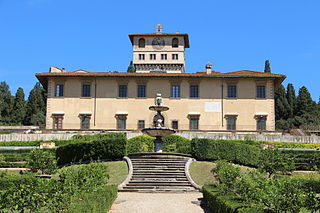
Villa La Petraia is one of the Medici villas in Castello, Florence, Tuscany, central Italy. It has a distinctive 19th century belvedere on the upper east terrace on axis with the view of Florence.

Palazzo Besta is a Renaissance building in Teglio, in the province of Sondrio, Lombardy, northern Italy.

The Polo Museale del Lazio is an office of Italy's Ministry of Cultural Heritage. Its seat is in Rome in the Palazzo Venezia.
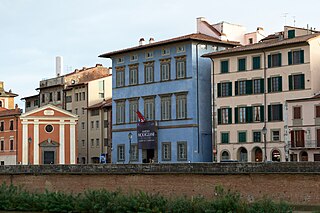
Palazzo Blu is a center for temporary exhibitions and cultural activities located in 9 Lungarno Gambacorti, in the heart of the historic center of Pisa, Italy. This museum is managed by the Fondazione Palazzo Blu, and is located in the Palazzo Giuli Rosselmini Gualandi, ancient palace restored by the Fondazione Pisa. Its name comes from the blue color uncovered during an architectural recent restoration, and attributable to the taste of Russian owners who acquired the Palazzo in the eighteenth century.

The Casino Mediceo di San Marco is a late-Renaissance or Mannerist style palace located on Via Cavour number 57 and via San Gallo in Florence, region of Tuscany, Italy.
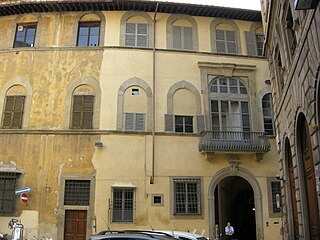
The Palazzo or Casa Martelli was a residential palace, and since 2009, a civic museum displaying in situ the remains of the original family's valuable art collection, as well as its frescoed rooms. The palace is located on Via Ferdinando Zannetti 8 near the corner with Via Cerretani in central Florence, region of Tuscany, Italy.
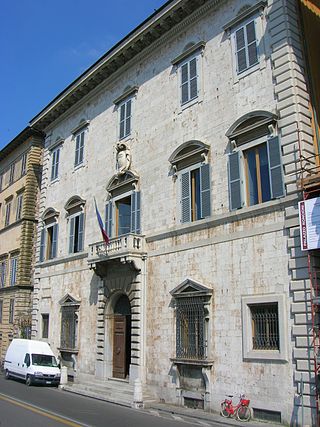
The Palazzo Lanfranchi-Toscanelli, presently the local State Archives, is a Renaissance-style palace located on Lungarno Mediceo #30, in the city of Pisa, region of Tuscany, Italy. Since 1913 the building has housed the Archivio di Stato di Pisa.
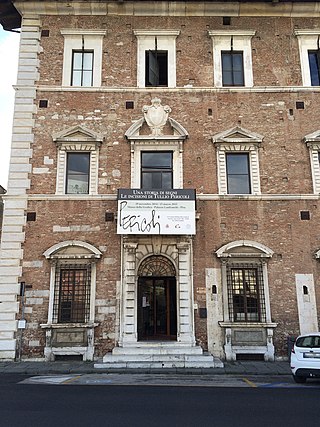
The Palazzo Lanfranchi is a palace located on Lungarno Galileo Galilei #8, in the city of Pisa, region of Tuscany, Italy.

The Palazzo Vecchio de' Medici, also called the Palazzo della Prefettura is a Gothic revival-style palace located on Piazza Giuseppe Mazzini #7, in the city of Pisa, region of Tuscany, Italy.

The Palazzo degli Anziani also known as the Palazzo del Comune, della Comunitá or del Giano is a Gothic-style stone palace located in the ancient historic center of Pistoia, Tuscany, Italy. The palace served as city hall for centuries; it still belongs to the comune and now mainly houses the Museo Civico d'Arte Antica.

The Museums of Florence form a key element of the cultural and artistic character of the city. Of the 15 most visited Italian art museums and galleries, five are in Florence. The number and proximity of the works of art in the museums of Florence can trigger the Stendhal syndrome on visitors who try to see them all, as evidenced by hospital records of hundreds of visitors each year affected by the syndrome. The art in Florence was one of the elements that contributed to the central part of the city being named a UNESCO World Heritage Site.
















